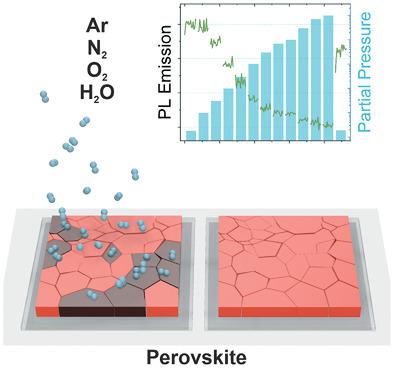当前位置:
X-MOL 学术
›
Adv. Opt. Mater.
›
论文详情
Our official English website, www.x-mol.net, welcomes your
feedback! (Note: you will need to create a separate account there.)
Unraveling Reversible Quenching Processes of O2, N2, Ar, and H2O in Metal Halide Perovskites at Moderate Photon Flux Densities
Advanced Optical Materials ( IF 8.0 ) Pub Date : 2020-09-13 , DOI: 10.1002/adom.202001317 Edgar R. Nandayapa 1 , Katrin Hirselandt 1 , Christine Boeffel 2 , Eva L. Unger 1 , Emil J. W. List‐Kratochvil 1, 3
Advanced Optical Materials ( IF 8.0 ) Pub Date : 2020-09-13 , DOI: 10.1002/adom.202001317 Edgar R. Nandayapa 1 , Katrin Hirselandt 1 , Christine Boeffel 2 , Eva L. Unger 1 , Emil J. W. List‐Kratochvil 1, 3
Affiliation

|
Metal halide perovskites (MHP), as used in photovoltaic (PV) applications, show a rich photophysics in inert and ambient atmosphere. The presence of atmospheric molecules leads to processes that enhance as well as reduce their photoluminescence (PL) emission. Various phenomena are previously described for a wide variety of gas molecules and different classes of MHP, with a particular interest on the long-term stability for PV applications. However, reversible PL quenching (PLQ) processes, which may be regarded equally important for the performance of PV and other optoelectronic applications, are neglected in other studies. This holds true for O2 and H2O, but especially for low-reactive gases such as nitrogen and argon. Using low excitation densities, it is shown that noticeable—and reversible—PLQ, in addition to PL enhancements, can already be observed for O2, N2, and Ar as well as for H2O at low concentrations of 1 mbar. The nature and origin of the quenching processes are further elucidated by applying the Stern–Volmer analysis, also employed to determine whether static and dynamic PLQ processes happen for the different quenching gases. The strongest static PLQ is found for O2 and H2O. MHPs in N2 and Ar atmospheres display a moderate PLQ effect.
中文翻译:

在中等光子通量密度下解开金属卤化物钙钛矿中 O2、N2、Ar 和 H2O 的可逆淬火过程
用于光伏 (PV) 应用的金属卤化物钙钛矿 (MHP) 在惰性和环境大气中显示出丰富的光物理特性。大气分子的存在导致增强和降低其光致发光 (PL) 发射的过程。先前针对各种气体分子和不同类别的 MHP 描述了各种现象,特别关注 PV 应用的长期稳定性。然而,可逆 PL 淬火 (PLQ) 过程可能被认为对 PV 和其他光电应用的性能同样重要,但在其他研究中却被忽略了。这适用于 O 2和 H 2O,但特别适用于低反应性气体,如氮气和氩气。使用低激发密度,表明除了 PL 增强之外,对于 O 2、N 2和 Ar 以及在 1 mbar 的低浓度下的H 2 O,已经可以观察到显着且可逆的 PLQ 。通过应用 Stern-Volmer 分析进一步阐明了淬火过程的性质和起源,也用于确定不同淬火气体是否发生静态和动态 PLQ 过程。O 2和H 2 O 的静态PLQ 最强。N 2和Ar 气氛中的MHP显示出中等PLQ 效应。
更新日期:2020-09-13
中文翻译:

在中等光子通量密度下解开金属卤化物钙钛矿中 O2、N2、Ar 和 H2O 的可逆淬火过程
用于光伏 (PV) 应用的金属卤化物钙钛矿 (MHP) 在惰性和环境大气中显示出丰富的光物理特性。大气分子的存在导致增强和降低其光致发光 (PL) 发射的过程。先前针对各种气体分子和不同类别的 MHP 描述了各种现象,特别关注 PV 应用的长期稳定性。然而,可逆 PL 淬火 (PLQ) 过程可能被认为对 PV 和其他光电应用的性能同样重要,但在其他研究中却被忽略了。这适用于 O 2和 H 2O,但特别适用于低反应性气体,如氮气和氩气。使用低激发密度,表明除了 PL 增强之外,对于 O 2、N 2和 Ar 以及在 1 mbar 的低浓度下的H 2 O,已经可以观察到显着且可逆的 PLQ 。通过应用 Stern-Volmer 分析进一步阐明了淬火过程的性质和起源,也用于确定不同淬火气体是否发生静态和动态 PLQ 过程。O 2和H 2 O 的静态PLQ 最强。N 2和Ar 气氛中的MHP显示出中等PLQ 效应。











































 京公网安备 11010802027423号
京公网安备 11010802027423号